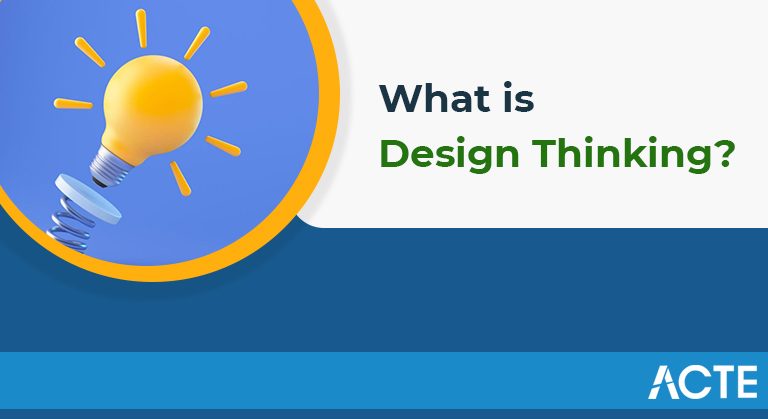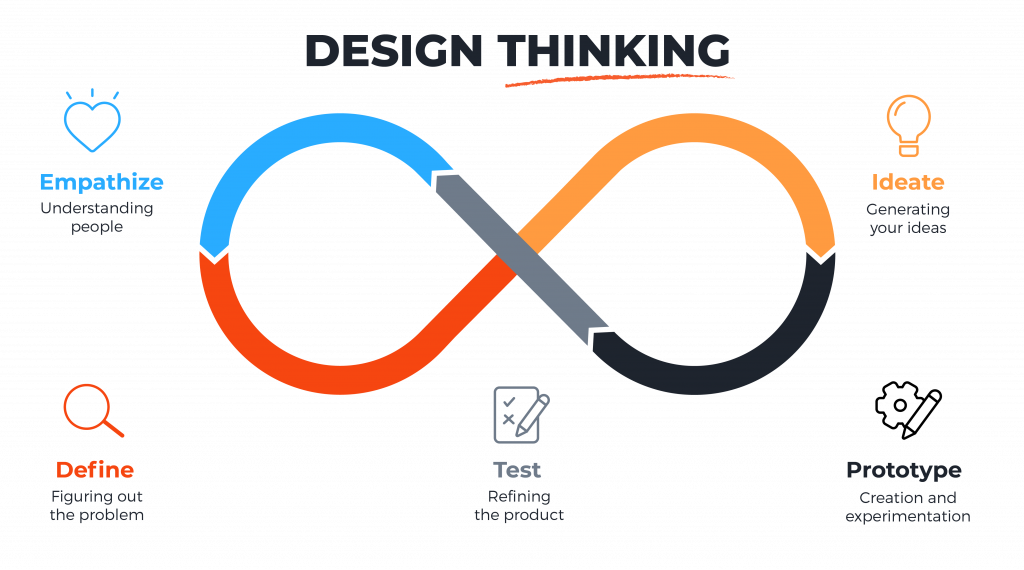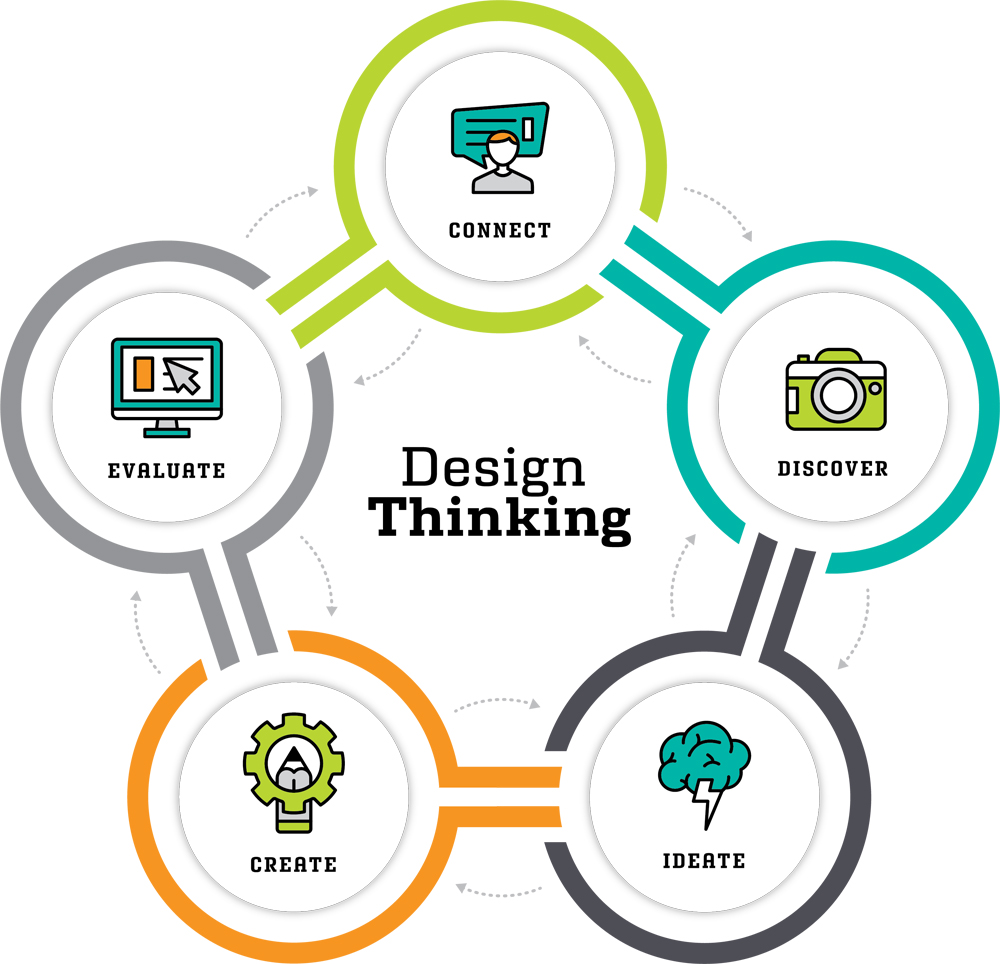
As time passes by, the importance of design thinking has been consistently increasing in the modern world. The consumers of today’s world can access global markets quickly. Design Thinking has evaded the differences between physical and digital experiences.
- What is Design thinking?
- Why is Design thinking Important?
- The five phases of the Design thinking process
- What businesses and Roles can profit from Design thinking?
- A Brief History of Design Thinking
- How Design Thinking Has Helped Businesses in Promoting Innovation
What is Design thinking?

Design believing is an interaction for taking care of issues by focusing on the purchaser’s necessities regardless of anything else. It depends on noticing, with compassion, how individuals associate with their surroundings, and utilizes an iterative, involved way to deal with making inventive arrangements.
Design believing is “human-focused,” which implies that it utilizes proof of how buyers (people) really draw in with an item or administration, rather than how another person or an association figures they will connect with it. To be really human-focused, creators observe how individuals utilize an item or administration and keep on refining the item or administration to further develop the customer’s insight. This is the “iterative” a piece of Design thinking. It favors moving rapidly to get models out to test, rather than interminable examination or rumination.
Rather than conventional critical thinking, which is a straight course of distinguishing an issue and afterward conceptualizing arrangements, plan thinking possibly works assuming it is iterative. It is to a lesser extent a way to get to a solitary arrangement, and even more an approach to constantly develop your reasoning and react to shopper needs.
- Intends to settle a substantial human need: Utilizing an observational, human-driven methodology, groups can uncover problem areas from the customer that they hadn’t recently considered, ones that the purchaser may not know about. Design thinking can give answers for those problem areas whenever they’re distinguished.
- Handles issues that are uncertain or hard to characterize: Purchasers regularly don’t have the foggiest idea what issue they have that requirements addressing or they can’t express it. However, upon cautious perception, one can distinguish issues dependent on what they see from genuine buyer conduct instead of essentially working off of their thoughts of the customer. This characterizes vague issues and thus makes it more straightforward to surface arrangements.
- Prompts more creative arrangements: People are not fit for envisioning things that are not accepted to be conceivable, which makes it unthinkable for them to request things that don’t yet exist. Design thinking can assist with surfacing a portion of these obscure trouble spots that would somehow or another have never been known. Utilizing an iterative way to deal with tackle those issues frequently lead to non-self-evident, creative arrangements.
- Makes associations run quicker and all the more productively: Rather than investigating an issue for quite a while without formulating a result, plan thinking favors making models and afterward testing to perceive how successful they are.
Why is Design thinking Important?
Design thinking empowers associations to make enduring incentive for buyers. The cycle is valuable in any perplexing framework (not simply plan frameworks) since it:
The five phases of the Design thinking process:-

Design thinking follows a five-stage structure.
1. Identify
In this first stage, the creator notices shoppers to acquire a more profound comprehension of how they associate with or are impacted by an item or issue. The perceptions should occur with sympathy, which means keeping judgment and not bestowing assumptions of what the shopper needs. Seeing with sympathy is strong on the grounds that it can uncover issues the customer didn’t realize they had or that they couldn’t themselves express. Starting here, it’s more clear the human requirement for which you are planning.
2. Characterize
In this subsequent stage, you assemble your perceptions from the principal stage to characterize the issue you’re attempting to tackle. Ponder the troubles your purchasers are catching up on against, what they over and over battle with, and what you’ve gathered from how they’re impacted by the issue. When you blend your discoveries, you can characterize the issue they face.
3. Ideate
The following stage is to conceptualize thoughts regarding how to tackle the issue you’ve distinguished. These ideation meetings could be in a gathering, where your group accumulates in an office space that supports imagination and cooperation, an advancement lab, or should be possible performance. The significant part is to create a lot of various thoughts. Toward the finish of this interaction, you’ll think of a couple of thoughts with which to push ahead.
4. Model
This is the stage that transforms thoughts into a real arrangement. Models are not intended to be great. The place of a model is to come out rapidly with a substantial adaptation of the plan to perceive how it is acknowledged by buyers. Instances of models incorporate a greeting page to test customer longing for an item or a video that exhibits smoothed out calculated cycles.
5. Test
When you give a prototyped answer for shoppers, you should see how they collaborate with it. This testing stage is the one wherein you gather criticism on your work.
The plan thinking process is an iterative, rather than direct, one. Toward the finish of the fifth stage, you’ll probably need to return to one or a few of different stages. Maybe the testing has shown you really want to foster another model, for which you’d get back to the fourth stage. Or on the other hand maybe it’s shown that you’ve misdefined the buyer’s requirements. Assuming this is the case, you would need to get back to a previous phase of the interaction.
What businesses and Roles can profit from Design thinking?
While Design thinking started with originators, it is presently generally utilized by individuals from all disciplines. Indeed, even among plan offices the work is broadly cross-utilitarian: IDEO and comparable offices employ non-architects—cooks, engineers, social researchers, scholars—and coordinate them into their undertaking groups to add viewpoint.
Our development advancement group at WeWork contains a fashioner, who centers around applying this strategy for the end shopper of a task; a technologist, who utilizes this procedure to convey worth to engineers; and a business specialist, who applies this technique to convey an incentive for entrepreneurs and different partners.
Design thinking has been utilized at Kaiser Permanente to redesign the arrangement of shift changes among nursing staff. It has helped the Singapore government make the interaction for getting a work pass in the country state simpler and more human. Design thinking has been utilized to take care of business issues at organizations like Toyota, Intuit, SAP, and IBM.
One justification behind the expansion of Design thinking in enterprises is that it’s valuable to separate issues in any mind boggling framework, be it business, government, or social associations. It tends to be utilized to investigate central issues concerning how to react to the development of innovation and globalization, how to turn in light of quick change, and how to help people while obliging bigger associations.
Design thinking can be involved by all offices in a business. It very well may be encouraged by splendid, vaporous actual work areas that take into account the manner in which representatives like to work. To utilize Design thinking in all undertakings, directors should initially characterize the shoppers they’re attempting to help and afterward utilize the five phases of Design thinking to characterize and handle the distinguished issues. Utilizing a plan thinking process makes it more probable a business will be inventive, innovative, and at last more human.
- Design Thinking, initially alluded to as Design Science, as a discipline came to fruition during the 1960s with an emphasis on design and designing. Taking care of issues in modern plan lead to the utilization of the logical strategy to customary plan thinking standards. Buckminster Fuller pointed toward making the “plan science upset” fusing levelheaded idea with science and innovation to tackle issues made by the quick headway of innovation.
- Fuller needed to touch off an upheaval with Design Science and delivered of World Design Science Decade in 1961. Nonetheless, it wouldn’t be until 1969 that this was additionally extended by Herbert Simon in The Sciences of the Artificial. Simon added new contemplations and boundaries to the plan hypothesis and proposed the possibility that anything planned was counterfeit rather than normal. This thought would later altogether affect plan hypothesis and Artificial Intelligence.
- From that point, Design Science proceeded to construct and grow moving from scholarly hypothesis to real practice and application. In 1973, Horst Rittel and Melvin Webber originally utilized the term Wicked Problems, deciphering Fuller’s concept of Design Science into an attention on plan and the human experience. Rittel instituted the expression “insidious issue” to include the intricacy of issues experienced during arranging. These issues are practically undefinable just as unsolvable like neediness and schooling.
- You might be considering what “insidious issues” has to do with Design Thinking. This hypothesis acquainted phenomenology with the blend, further zeroing in on the experience of the end client. This attention on experience prompts the improvement of what we know as Design Thinking today. Richard Buchanan distributed Wicked Problems in Design Thinking in 1992, consolidating speculations generated by Fuller, Simon, and Rittle into one durable hypothesis. This article is seen by numerous individuals as a foundation of the Design Thinking field. Through his reasoning, schools like Carnegie Mellon started to show administration Design including this as a critical component to scale and assemble innovation, business and the sky is the limit from there.
- Design Thinking surprised the world during the 1990s because of the ascent of the Dot-Com business blast. Organizations who effectively incorporated the client experience and Design Thinking into their organizations had the option to “increase” as indicated by Buchanan’s hypothesis and adjust to the evolving market. As client experience transformed from an untimely idea to the front line of current business, Design Thinking turned into a fundamental piece of the situation.
A Brief History of Design Thinking:-
How Design Thinking Has Helped Businesses in Promoting Innovation:-
As expressed before, plan thinking includes examining all features of a venture prior to hopping in to address it. This very perspective advances human-focused development. For any issue, the drive is to consistently bounce into addressing it, and this can prompt errors, time wastage, and bombed projects. A few advantages of the plan thinking approach include:
Limiting Risk: As the interaction draws in clients and clients, the dangers and vulnerability that accompany advancement are limited.
Genuine Insights: The interaction depends on experiences attracted from genuine clients this present reality, not simply statistical surveying.
Promptly Applicable: To turn into a plan mastermind, you don’t have to go through long periods of studies to be a creator. You can promptly become familiar with the abilities and apply them to driving administration and advancement.
It Helps You to Think Strategically: This is on the grounds that you initially need to evaluate every issue from all aspects then, at that point, map a system for handling it.
Better Business Performance: Organizations have utilized plan thinking with incredible achievement. We talk about a model for the situation concentrate underneath.
Conclusion:-
With this, we came to an end with the article. We have covered all the essential concepts of design thinking. I hope you are satisfied with the fundamentals of the importance of design thinking in your organisation.




